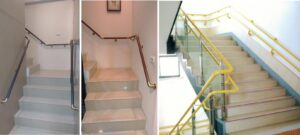As society develops and progresses, installing Safety Grab bars (safety handrails) on indoor staircases has become an effective measure to demonstrate humanitarian care. Safety handrails are becoming an indispensable indoor safety measure. Although their application is quite common in specific places such as hospitals, nursing homes, and kindergartens, the prevalence of safety handrails on indoor staircases in non-specific public places remains low, especially in poorer regions and countries. The lack of safety handrails is largely due to insufficient recognition of their importance and a lack of attention to the issue.
The Origin of Safety Handrails
In the early 20th century, driven by the call for humanitarianism, a new architectural design method—barrier-free design—emerged in the Western architectural field. The purpose of barrier-free design is to use modern technology to provide safe and convenient spaces for the elderly, disabled, women, and children, thereby creating an inclusive and participatory environment. Safety handrails, as part of barrier-free design, are not limited to indoor staircases but also include restrooms and public toilets. This design aims to help the elderly and disabled walk and navigate stairs, enhancing the safety and convenience of public facilities.
The Importance of Installing Safety Handrails
According to domestic building regulations, only buildings taller than seven stories are required to have elevators. However, in many third- and fourth-tier cities, most buildings are seven stories or fewer. This means that most buildings remain basic residential units, with residents relying on indoor staircases for daily vertical movement. For elderly individuals and those with weaker physical conditions, navigating stairs can be a significant challenge, demanding both physical strength and coordination, and posing a risk of accidents.
Installing safety handrails on indoor staircases can provide physical support for those with weaker conditions, offering better security when navigating stairs. This not only reflects societal care but also signifies progress. Installing safety handrails helps prevent falls and other accidents, enhancing the safety and comfort of living environments, and promoting the independence and quality of life for the elderly and disabled.
With the impact of global aging and the increasing emphasis on barrier-free design and humanitarian care, installing safety handrails is a socially significant measure. In the future, more public places and residential staircases will likely be equipped with safety handrails, creating a safer, more convenient, and equitable living environment for everyone.

